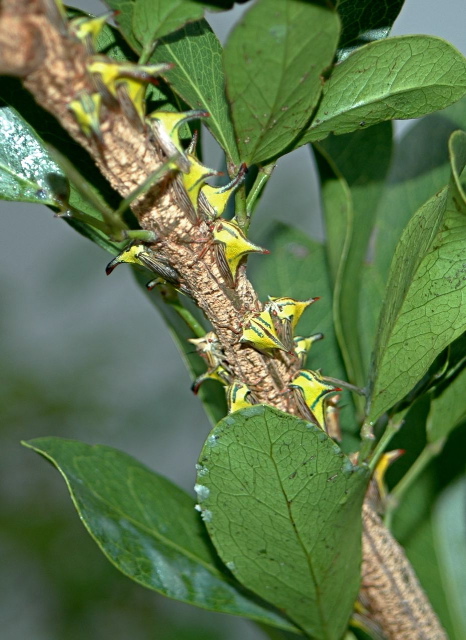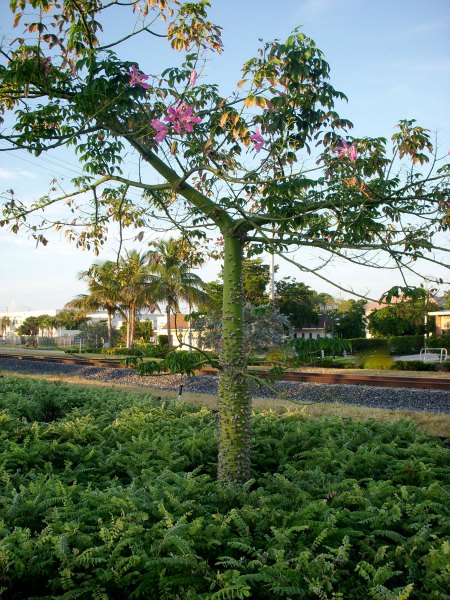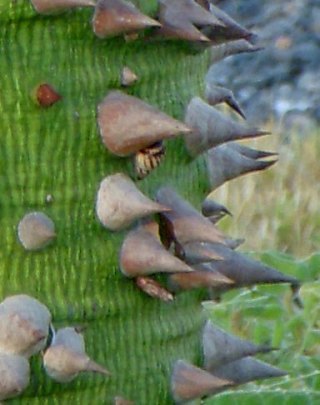The other day I was talking about spines on palm trees and got to thinking about defensive strategies of plants in general. It seems like there’s a general arms race going on between primary producers (organisms that convert sunlight into energy that sustains them) and primary consumers (organisms that capture that energy by feeding on the primary producers). Since most primary producers are plants and algae, by definition most primary consumers are herbivores. So in order for a plant to pass on its genes to its descendants, it must ensure that it survives long enough to reproduce.
One way to do this is to defend against being eaten. Trees are at the base of the food chain, and they are immobile, so they need to mount some form of defense. Thorns and spines often do the trick, as I mentioned earlier, but it’s not just palm trees that develop them.
Take, for instance, the lovely floss silk tree (Chorisia speciosa). Here’s one on Dixie Highway in Boca Raton:
The flowers are lovely, and the green trunk is quite striking. But take a closer look—not too close! You don’t want to run into those thorns!
Those thorns are quite impressive, making this lovely tree less than appealing, at least to tree-climbing mammals that might want to sample its leaves or flowers. Other organisms, though, have become so adept at adaptation that they actually benefit from the defensive strategies of some plants!
For example, Florida’s endangered tree snail, Liguus fasciatus, appears pretty comfortable among the thorns on that Floss silk tree! In case you missed it from the picture above, here’s a cropped detail:
Not many predators of snails would think to sample every thorn on that trunk just to get at that delicious molluscan meal. Mind you, I’m not saying that Florida tree snails evolved to mimic the thorns on the exotic tree native to South America; that doesn’t make any sense at all. But it certainly seems like this Boca-based snail is enjoying a free ride.
But as I said at the beginning, it’s an arms race: as trees evolve defenses against being eaten, animals evolve ways of getting around those defenses. Some animals, like birds, bats, or insects, can simply fly right past the trunk to get to the mother lode. And that’s important for many plants because those flying creatures are important pollinators (unless you’re lazy, like conifers, and just release all your pollen into the wind and hope for the best—a strategy that works pretty well, as long as your population exists in big open spaces that allow the wind to disseminate your pollen long distances, and you produce enough pollen and have a large enough population to enable pollination to be successful despite all the “missed targets” that this “sème à tout vent” strategy entails).
But you still need to defend against insect damage somehow. Conifers do it with thick bark, copious amounts of resin to attack anyone who gets through the bark, and large spiny pine cones to protect the seeds.
Despite all this arming-up on the part of the trees, insects have a major advantage: their furious rates of reproduction. They can have scores of generations over which minor mutations can get tested in populations while one sapling grows into a young tree. These Furthermore, it’s not just mollusks that use a plant’s defenses for their own benefit, though. Insects have also learned to masquerade as thorns:

Unlike the almost completely benign feeding of the tree snail, though, which contents itself with “cleaning” the bark of the tree of the lichens that grow on the surface, the thorn bug, Umbonia crassicornis, is a sapsucker. It feeds directly on the life juices of the host plant itself. It doesn’t seem like these guys are numerous enough or voracious enough to cause major problems for the plant, though, unlike other arthropod infestations, which can defoliate and destroy trees or even whole forests (think bark beetles in the forests out west).
Camouflage is an enormous topic, though, so I’ll stop here and rest a bit…




I think I once read that certain birds impale insects on these thorns and then return later to eat. Have you read anything similar ? Thanks. Rick